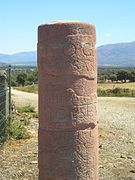Miliarium

A miliarium (Classical Latin: [miːllɪˈaːrɪ.ũː ˈau̯rɛ.ũː]) was a cylindrical, oval or parallelepiped column placed on the edge of Roman roads to mark the distances every thousand passus (double Roman steps), that is, every mile.[1] Today, this is equivalent to a distance of approximately 1480 meters.[1] The stone known as the Milliarium Aureum the point used to indicate the distance to Rome from any point in the Roman Empire.[2]
Background
[edit]The columns were made of granite, marble or whatever local stone was available. Each had a cubic or square pedestal and measured between 6.6 to 13.1 feet (2.0 to 4.0 m), with a diameter of 19.5 to 31.5 inches (50 to 80 cm).[citation needed] Miliarium were widely used by Roman road builders and were an important part of any road network. In those times, the distance that could be travelled each day was sometimes only a few miles.[citation needed] Many miliaria only record the name of the reigning emperor without giving any placenames or distances.[3] The first known miliaria appeared on the Appian Way during the final period of the Roman Republic, but the vast majority of that still exist were made during the High Empire and, to a lesser extent, in the 3rd and 4th centuries.[4]
Most of the milestones carried directly engraved inscriptions, depending on the importance of the road or the proximity or distance from Rome, or the cities of origin and destination. The inscription always consisted of a series of well-defined parts:[5]
- The full title of the emperor under whose rule the road was built or modified.
- The distance to Rome or the most important town on the route.
- The governor and/or the military unit responsible for the works on the road.
- The expression refecit or reparavit if it was a road maintenance work
In the 4th century, the milestones lost their usefulness as mileposts, becoming an element of political propaganda for the emperors.
In the Western Roman Empire, the last miliaria were made at the time of the emperors Theodosius I and Honorius. With the barbarian invasions and the Fall of the Western Roman Empire, they ceased to be carved when the maintenance of the roads disappeared.[citation needed] In the Eastern Roman Empire, the roads continued to be maintained until the 6th century, although the miliaria became increasingly rare until they were no longer erected. Being written in Latin, they lost their functionality among a population that spoke mainly Greek.[citation needed]
Gallery
[edit]-
Roman milestone of Emperor Trajan Decius, found in Borriol, Spain
-
Nero's miliarium on the Vía de la Plata in the Municipium Capara, in the northern part of the Province of Cáceres.
-
Milliarium Aureum in the Roman Forum
Further reading
[edit]- Moreno Gallo, Isaac (2006). Vías Romanas — Ingeniería y técnica constructiva (PDF) (in Spanish). Ministerio de Fomento, Dirección General de Carreteras. ISBN 84-7790-404-9. Archived from the original (PDF) on October 5, 2010.
- Arias, Gonzalo [in Spanish] (2004). Repertorio de Caminos de la Hispania Romana, Pórtico librerías (in Spanish) (2 ed.). Gonzalo Arias. ISBN 978-84-609-0294-2.
See also
[edit]References
[edit]- ^ a b A passus is an ancient Roman unit of length that is 2 gradūs. One passus is 1.62 yards (1.48 m). There are 1000 passus in one mille, which was sometimes referred to as a mille passus. A passus was roughly the pace step of a single legionary.
- ^ Lajo Pérez, Rosina (1990). Léxico de arte (in Spanish). Madrid: Akal. p. 134. ISBN 9788476004937.
- ^ Collingwood, R. G.; Wright, R. P. (1965). The Roman Inscriptions of Britain. I: Inscriptions on stone. Oxford: Clarendon Press.
- ^ Nouwen, Robert (2004). "Over de wegen van de keizer. Mijlpalen en de imperiale communicatiepolitiek in de Gallische en Germaanse provincies" [On the Ways of the Emperor Milestones and Imperial Communication Policy in the Gallic and Germanic Provinces]. Vlaanderen (in Dutch). pp. 160–161.
- ^ Martins Capela, Manuel José [in Portuguese] (1895). Miliários Do Conventus Bracaraugustanus Em Portugal [Milestones from the Conventus Bracaraugustanus in Portugal]. Porto.
{{cite book}}: CS1 maint: location missing publisher (link)
External links
[edit]- El Miliario Extravagante, by Gonzalo Arias. Map-Index of the Roman Roads of Hispania, catalog of roads, index of mansions and cities of Roman Hispania.
- Epigrafía, the Anticuarius Innovation Project, Universidad Complutense de Madrid


